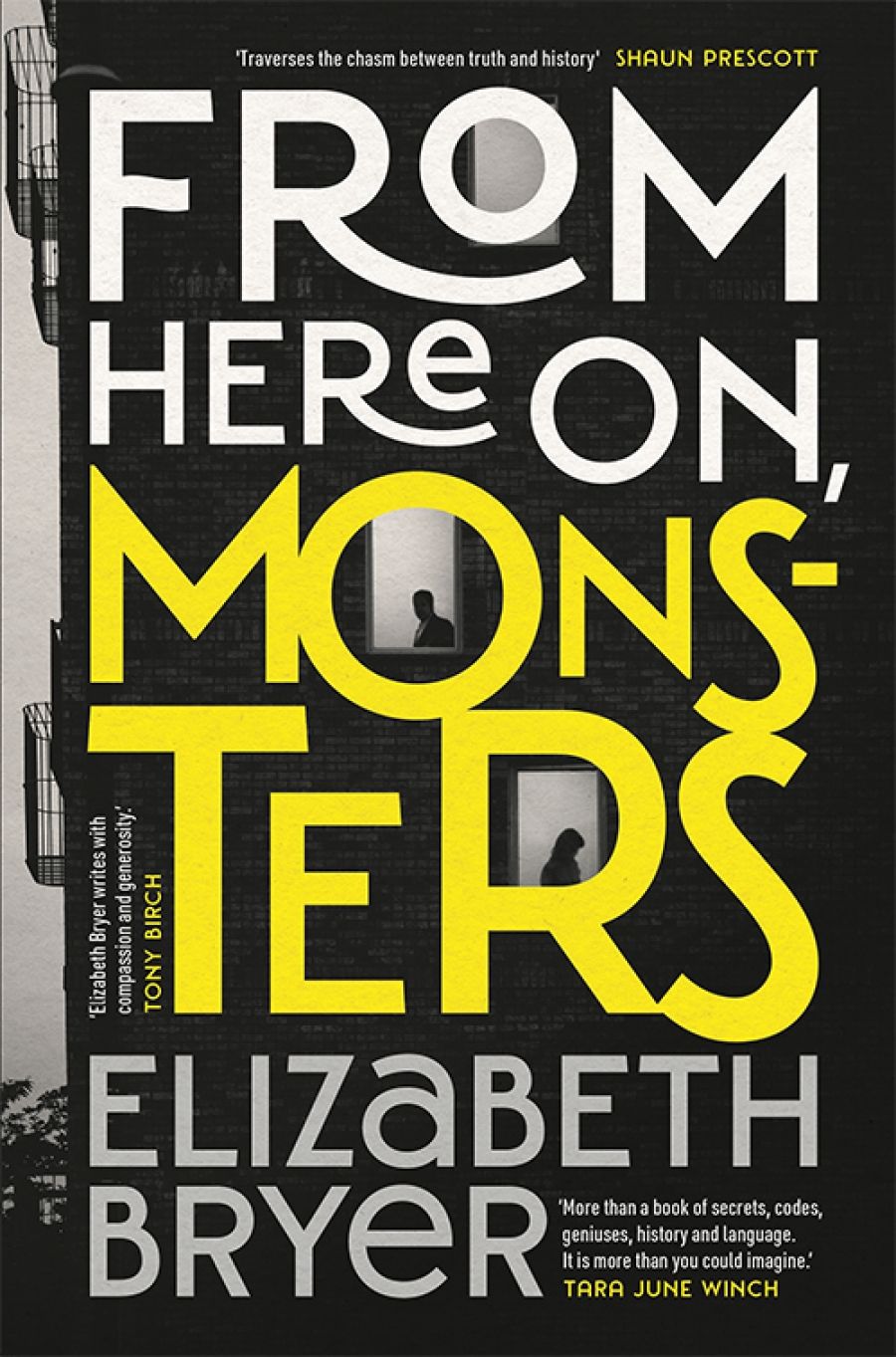
- Free Article: No
- Contents Category: Fiction
- Review Article: Yes
- Online Only: No
- Custom Highlight Text:
The most charismatic of the many monsters in Elizabeth Bryer’s début novel is the conceptual artist Maddison Worthington, who commands attention with her lipstick of ‘Mephistophelian red’ and her perfume of ‘white woods, musk and heliotrope’. From the solitude of a labyrinthine mansion ...
- Grid Image (300px * 250px):

- Alt Tag (Grid Image): James Halford reviews 'From Here on, Monsters' by Elizabeth Bryer
- Book 1 Title: From Here on, Monsters
- Book 1 Biblio: Picador, $29.99 pb, 272 pp, 9781760781132
Bryer’s entry into this challenging terrain looks to unsettle our assumptions about asylum. From Here On, Monsters audaciously departs from journalistic, documentary, and testimonial approaches. It might be more fruitfully read in the tradition of aesthetically radical engagements with the topic by performance artists like Mike Parr, Mireille Eid (Astore), and Shahin Shafaei, or theatremakers like Victoria Carless and Ben Eltham. The novel flaunts historical verisimilitude in order to expose fictionality as a rhetorical mode that saturates the public discourse around asylum seekers: from John Howard’s fictions of queue jumpers and children overboard, to Peter Dutton’s risible recent insinuation that pregnant rape victims on Nauru are ‘trying it on’. Bryer’s text signposts its concern with fiction-making in a variety of ways, but the most significant is its depiction of an alternative Australia in which large numbers of ‘irregular’ asylum seekers live secretly in the community, like the sanspapiers in France or clandestinos in the United States, instead of being held in detention centres. It is as if the novel refuses to see the camps – ‘What is unpronounced tends to non-existence’, reads the epigram from Czesław Miłosz – but insists on seeing the people inside them, who are relocated to the centre of an unnamed capital city very like Melbourne.
While the exact nature of Worthington’s ‘Excise Our Hearts’ project is part of the mystery that keeps us reading, we know it will involve her hallmarks of deception, performance, and embodiment. It also requires her naïve assistant Cameron, the novel’s narrator, to dress up as a bureaucrat – as if participating in the Stanford Prison Experiment – and to invent border-related euphemisms for hours on end. Cameron’s gradual discovery of the project’s goal – to ensure ‘a degree of disposition toward compliance’ with the government’s harsh new border-protection policies – undermines her admiration of Maddison and eventually leads her to rebel: the main character arc of the novel.
 Elizabeth Bryer (photograph by Percy Cáceres/Pan Macmillan Australia)
Elizabeth Bryer (photograph by Percy Cáceres/Pan Macmillan Australia)
In a second crucial narrative strand, Cameron shelters an asylum seeker, Jhon Dikua Mba, a polyglot lawyer from Equatorial Guinea. Cameron gives Jhon informal work at the second-hand bookstore she inherited from her mentor and boss, Alister, whose sudden suicide fifteen months earlier has left her feeling ‘quarried out’. Both host and guest find solace in this encounter and throw themselves into intellectual projects. As Cameron is drawn deeper into Worthington’s maze of deceit, Jhon grows ever more frightened of his nights alone in the bookstore, convinced that he can hear a monster bellowing in the building opposite.
At the same time, both become obsessed with the task of translating a mysterious codex that once belonged to the missing historian George Szilard (the surname is one of the novel’s many allusions to eminent intellectual asylum seekers of the century past). Szilard’s eccentric vision of history writing as material embodiment leads him to write his final academic monograph in medieval Spanish on palm leaves in emulation of the source: a long-lost thirteenth-century translation of Sinbad the Sailor from the One Thousand and One Nights. The highly imaginative and entertaining history of this manuscript, interpolated into Bryer’s novel, serves as evidence of cultural exchange between Muslims and Aboriginal Australians prior to 1788. Through its imaginative recuperation of non-white history in the Pacific contact-zone to Australia’s north, From Here On, Monsters looks to counterbalance racially exclusionary narratives of settler-colonial nation building.
While the novel is suspenseful and well-paced, the onward rush of events necessitated by the genre limits its opportunities to deeply explore character. As a result, the asylum seekers seem thin and somewhat idealised, and the climactic confrontation between the monstrous artist and her protégée lacks emotional weight. Nonetheless, there is much to admire about the book’s formal risk-taking and narrative energy, as well as the breadth and inventiveness of its ideas.


Comments powered by CComment